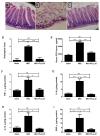Curcumin and Intestinal Inflammatory Diseases: Molecular Mechanisms of Protection
- PMID: 31003422
- PMCID: PMC6514688
- DOI: 10.3390/ijms20081912
Curcumin and Intestinal Inflammatory Diseases: Molecular Mechanisms of Protection
Abstract
Intestinal inflammatory diseases, such as Crohn's disease, ulcerative colitis, and necrotizing enterocolitis, are becoming increasingly prevalent. While knowledge of the pathogenesis of these related diseases is currently incomplete, each of these conditions is thought to involve a dysfunctional, or overstated, host immunological response to both bacteria and dietary antigens, resulting in unchecked intestinal inflammation and, often, alterations in the intestinal microbiome. This inflammation can result in an impaired intestinal barrier allowing for bacterial translocation, potentially resulting in systemic inflammation and, in severe cases, sepsis. Chronic inflammation of this nature, in the case of inflammatory bowel disease, can even spur cancer growth in the longer-term. Recent research has indicated certain natural products with anti-inflammatory properties, such as curcumin, can help tame the inflammation involved in intestinal inflammatory diseases, thus improving intestinal barrier function, and potentially, clinical outcomes. In this review, we explore the potential therapeutic properties of curcumin on intestinal inflammatory diseases, including its antimicrobial and immunomodulatory properties, as well as its potential to alter the intestinal microbiome. Curcumin may play a significant role in intestinal inflammatory disease treatment in the future, particularly as an adjuvant therapy.
Keywords: Crohn’s disease; curcumin; inflammatory bowel disease; necrotizing enterocolitis; ulcerative colitis.
Conflict of interest statement
The authors declare no conflict of interest.
Figures



Similar articles
-
Role of antibiotics for treatment of inflammatory bowel disease.World J Gastroenterol. 2016 Jan 21;22(3):1078-87. doi: 10.3748/wjg.v22.i3.1078. World J Gastroenterol. 2016. PMID: 26811648 Free PMC article. Review.
-
The Roles of Inflammation, Nutrient Availability and the Commensal Microbiota in Enteric Pathogen Infection.Microbiol Spectr. 2015 Jun;3(3). doi: 10.1128/microbiolspec.MBP-0008-2014. Microbiol Spectr. 2015. PMID: 26185088
-
Effects of curcumin plus Soy oligosaccharides on intestinal flora of rats with ulcerative colitis.Cell Mol Biol (Noisy-le-grand). 2017 Aug 15;63(7):20-25. doi: 10.14715/cmb/2017.63.7.3. Cell Mol Biol (Noisy-le-grand). 2017. PMID: 28838334
-
Rationale for probiotic and antibiotic treatment strategies in inflammatory bowel diseases.Dig Dis. 2003;21(2):105-28. doi: 10.1159/000073243. Dig Dis. 2003. PMID: 14571109 Review.
-
The Intestinal Microbiota in Inflammatory Bowel Disease.ILAR J. 2015;56(2):192-204. doi: 10.1093/ilar/ilv030. ILAR J. 2015. PMID: 26323629 Review.
Cited by
-
Current Development and Future Application Prospects of Plants-Derived Polyphenol Bioactive Substance Curcumin as a Novel Feed Additive in Livestock and Poultry.Int J Mol Sci. 2022 Oct 7;23(19):11905. doi: 10.3390/ijms231911905. Int J Mol Sci. 2022. PMID: 36233207 Free PMC article. Review.
-
Impregnation of Curcumin into a Biodegradable (Poly-lactic-co-glycolic acid, PLGA) Support, to Transfer Its Well Known In Vitro Effect to an In Vivo Prostate Cancer Model.Nutrients. 2019 Sep 29;11(10):2312. doi: 10.3390/nu11102312. Nutrients. 2019. PMID: 31569529 Free PMC article.
-
Treatment of colitis by oral negatively charged nanostructured curcumin in rats.Acta Cir Bras. 2022 Aug 15;37(6):e370602. doi: 10.1590/acb370602. eCollection 2022. Acta Cir Bras. 2022. PMID: 35976279 Free PMC article.
-
The Role of Glycosaminoglycans in Protection from Neonatal Necrotizing Enterocolitis: A Narrative Review.Nutrients. 2020 Feb 20;12(2):546. doi: 10.3390/nu12020546. Nutrients. 2020. PMID: 32093194 Free PMC article. Review.
-
Oral colon-targeting core-shell microparticles loading curcumin for enhanced ulcerative colitis alleviating efficacy.Chin Med. 2021 Sep 22;16(1):92. doi: 10.1186/s13020-021-00449-8. Chin Med. 2021. PMID: 34551815 Free PMC article.
References
-
- Dias A.M., Correia A., Pereira M.S., Almeida C.R., Alves I., Pinto V., Catarino T.A., Mendes N., Leander M., Oliva-Teles M.T., et al. Metabolic control of T cell immune response through glycans in inflammatory bowel disease. Proc. Natl. Acad. Sci. USA. 2018;115:E4651–E4660. doi: 10.1073/pnas.1720409115. - DOI - PMC - PubMed
Publication types
MeSH terms
Substances
Grants and funding
LinkOut - more resources
Full Text Sources
Medical

